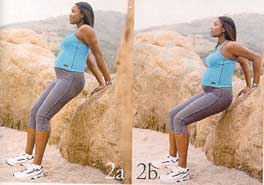
"We
asked a number of Canadian moms and dads what wisdom
(things they wish they'd known when they were new parents)
they would pass on to new or expectant parents. This
is what they had to say." Click
here to read more.
This article is in Adobe PDF format; if you do not have
Acrobat, please
click here to download.
Stride Right
Stay strong and healthy the whole
nine months with our complete guide to walking and running.
BY TRACY TEARE PHOTOGRAPHY BY REED
DAVIS
A mother of twins, Tracy Teare writes
for Walking magazine and is a frequent contributor to
Fit Pregnancy.
Cheryle Kruse Shwe, 34, a running coach,
ran between 15 and 35 miles a week in San Francisco
until the day she delivered her baby. Juliet Hochman,
34, a former Olympic rower from Portland, Ore., traded
running from power walks partway through both of her
pregnancies. And they're not alone.
Not Long ago, pregnancy was a time to
put up your feet, not lace up your running shoes. But
these days, a lot of women are benefiting from staying
active through pregnancy. One of the best and easiest
ways to do that is by walking or running.
The important thing about exercise during
pregnancy is to just do it. "During a normal, healthy
pregnancy, women who exercise will experience benefits
to both mother and baby," says Karen Nordahl, M.D.,
founder of the Fit to Deliver prenatal-fitness program.
"The benefits are both immeasurable, such as improved
sense of well-being, and measurable, such as a decrease
in fetal intervention at delivery."
FIND YOUR GROOVE
What ever exercise you do, be
prepared to adapt your routine to your growing belly:
Cut back on the number of days you work out, switch
to recumbent bicycling or, if you're a runner, try walking.
"Walking is a s effective as running, provided you walk
fast and far enough," says Susi Kerr, who co-developed
Fit to Deliver's programs.
Another good option is water running
in the deep end of a pool using either a flotation belt
or a pool noodle. "It's a good alternative if you feel
unstable on land but still want that endorphin release,
and if you want to keep cool," says Kerr.
Endorphins aside, whether you walk or
run, knowing you've helped give your baby a healthy
start in life is the biggest high of all.
HOW MUCH CAN YOU WALK OR RUN WHILE
PREGNANT?
Your distance, speed and intensity
will depend on whether you were a beginner, intermediate
or advance exerciser before you became pregnant (check
out the chart below for guidelines). Whatever your fitness
level, our guide to walking and running, created by
Karen Nordahl, M.D., personal trainer Susi Kerr and
physical therapist Carl Petersen of Fit to Deliver will
suit you. An extra perk: In addition to walking and
running, the program includes strength, flexibility
and balance components.
BEGINNER
1st Trimester
You were new to exercise prior to your
pregnancy. Start slowly with a simple walking program:
Walk for 30 minutes 2-3 times per week, with a day of
rest in between.
2nd trimester
You can begin to increase
the intensity of your walk. Warm up by walking briskly
for 5-10 minutes, then pick up the pace and power walk
(walk at a fast pace, pumping your arms) for 25 minutes.
Cool down by walking slowly for 5 minutes
3rd trimester
You should be able to power
walk for at least 30 minutes. If you aren't up to it,
ride a recumbent bike, use a stair climber or walk on
a treadmill. Your hips may not feel as stable as in
the second trimester, so stick to level terrain. Continue
to exercise at least twice a week and do the strength
training exercises .
INTERMEDIATE
1st Trimester
You were walking or running
consistently for at least 3 months prior to your pregnancy
for 10-15 total miles per week. You can continue the
same routine 3-4 times a week, with a day of rest in
between.
2nd trimester
If everything went well in
your first trimester and you are feeling up to it, you
can continue at the same pace.
3rd trimester
Continue your routine if you are still comfortable,
but stick to flat terrain. Decrease your mileage if
running becomes difficult; walk or cross train to maintain
your fitness level.
ADVANCED
1st trimester
You were running 15-20 miles a week consistently for
6 months or more prior to pregnancy and occasionally
competed in races. You can continue this routine except
for the racing. If you feel as if you are overexerting
yourself, walk or discontinue the routine until you
feel stronger.
2nd trimester
You can run as many as 5 days a week if you feel comfortable.
Work out in a pool on days when you are feeling tired
or are not up for a run.
3rd trimester
You surely are feeling the extra weight you are carrying.
If you still feel good and want to continue running,
then do so. You may find that you don't feel comfortable
running as long or for as many days a week as you did
in the first tow trimesters. If you feel unstable, walk
or continue your runs in a pool.
Knowing you've helped give your
baby a healthy start is the biggest high of all.
Be smart, be safe. Pregnancy is one
time when exercise is not about setting records. Instead,
your goal should be to optimize your and your baby's
health. Pay attention to how you feel, and monitor the
intensity and duration of your workouts. "Just because
you ran for an hour-and-a-half before you were pregnant
doesn't mean it's OK now," says Susi Kerr, a co-developer
of the Fit to Deliver exercise program. Keep these precautions
in mind when doing any type of exercise:
Use the talk test. "If you can carry on a conversation
throughout the whole workout, you're getting enough
oxygen for you and your baby," says Kerr (See page 115
for more guidelines from the American College of Obstetricians
and Gynecologists.)
Stop if you experience pain, fever, bleeding,
dizziness, faintness, pubic pain, persistent headache,
sudden swelling, difficulty walking, lack of normal
fetal movement or an abnormally rapid heartbeat.
Rest if you feel extreme fatigue. Listen to your
body, and don't overdo it.
Drink up. Add 8 ounces of water to your total
daily fluid intake for every 30 minutes of exercise.
Stay cool by dressing in breathable layers that you
can shed. In warm weather, exercise early or late in
the day, and ratchet down the intensity.
Watch your back. Back pain is common during pregnancy;
if you experience it, make sure your exercise routine
isn't the culprit.
Watch the clock. Don't work out at a high intensity
for more than 40 minutes at a time.
TRAINING TIPS
- Check with your doctor or midwife
before doing any type of exercise program.
- Start your walk or run by walking
or jogging slowly until you feel warm and limber.
- Do some flexibility exercises before
you run, including figure eights with your legs, mini-squats
and arm swings.
- Core stability and strength are
very important for the pregnant runner, so work on
the lower abdominals, obliques and side flexors, as
well as the back extensors and hips (see "Strength-Training
Moves" on page 80).
- If you experience discomfort and
choose to stop running, try walking and/or cross training
(ride a recumbent bike or try swimming or water running.)
- If your regular walking pace becomes
too much, don't force it. Slow down or cross train
instead.
- Cool down with 10 minutes of light
jogging or slow walking followed by easy stretches.
Professional volleyball player Annett
Davis 28, is shown here eight months pregnant. She continued
to exercise throughout her pregnancy, adapting her workout
to include walking, free weights and yoga.
Strength-training moves
Core and upper-body exercise can help
counter the poor posture (rounded shoulders and upper
back, exaggerated lower-back curve) that is often associated
with pregnancy. Here are 4 great moves that require
no equipment and easily can be incorporated into your
exercise program. You can even modify some of the exercises
as your pregnancy progresses.
For each exercise, do 2-3 sets of 12-15
reps, resting 30-60 seconds between sets. Do them on
the days that you run or walk. (You can do Cat Backs
and Back Presses daily.)
1. push-ups
Face a support, feet hip-width apart,
hands slightly wider than shoulders, arms straight.
Press hips forward so your body forms a straight line
(A). Bend elbows and lean chest toward the support until
elbows are about in line with shoulders (B). Push back to starting position and repeat. Strengthens
chest, front shoulders and triceps.
(B). Push back to starting position and repeat. Strengthens
chest, front shoulders and triceps.
TRIMESTER TIPS: You can do a traditional
push-up, with your hands on the ground, during the first
trimester. In your second trimester, do push-ups while
kneeling, with hands on a bench.
2. tri-dips
Stand with your back to a ledge offering
horizontal support, knees bent, feet flat on the ground. Place your hands
on the edge of the support close to your buttocks, fingertips
pointing forward, arms straight. Lift your buttocks
using your arms; squeeze shoulder blades down and together
(A). Without changing position, bend your elbows, lowering
your torso until elbows are about in line with shoulders
(B). Straighten arms without locking and repeat. Strengthens
triceps.
knees bent, feet flat on the ground. Place your hands
on the edge of the support close to your buttocks, fingertips
pointing forward, arms straight. Lift your buttocks
using your arms; squeeze shoulder blades down and together
(A). Without changing position, bend your elbows, lowering
your torso until elbows are about in line with shoulders
(B). Straighten arms without locking and repeat. Strengthens
triceps.
TRIMESTER TIP: If you're
strong enough during your first trimester, keep your
legs straight and feet flexed so you're supported on
your heels.
3.  cat
backs cat
backs
Kneel on the ground with your wrists
just in front of your shoulders and knees in line with
your hips. Keeping arms straight, inhale, lifting up
head and tailbone (A). Using your abdominals, exhale,
letting your head relax and rounding your spine like
a cat (B). Continue for reps in a rhythmic pattern.
Strengthens abdominals and  back. back.
4. back presses
Lean your entire back and buttocks against
a vertical support with your feet slightly forward,
knees slightly bent and arms crossed in front of your
chest or hanging by your sides (A) .
Use your abs to pull your navel toward your spine and
tilt the bottom of your pelvis upward (B). Hold for
20 seconds, then release and repeat. Continue to breathe,
still using your abs, for the entire 20 seconds. Strengthens
abs. .
Use your abs to pull your navel toward your spine and
tilt the bottom of your pelvis upward (B). Hold for
20 seconds, then release and repeat. Continue to breathe,
still using your abs, for the entire 20 seconds. Strengthens
abs.
Your body will thank you Moderate exercise
eases many pregnancy-related discomforts such as swelling,
nausea and leg cramps. It also reduces your risk of
developing gestational diabetes or requiring a Cesarean
section, episiotomy or other medical intervention during
delivery. Staying active can also help control excessive
weight gain and speed your recovery time once the baby
arrives. What's more, exercise benefits both mom and
baby by improving blood flow and circulation, according
to a study led by James F. Clapp III M.D., of Case Western
Reserve University in Cleveland.
Exercise Guidelines
The following is a summary of the American
College of Obstetricians and Gynecologist Guidelines
for exercising while pregnant (from ACOG Technical Bulletin,
No. 189, February 1994).
1. During pregnancy, you can continue
your mild to moderate exercise routines. It's best to
exercise at least three days a week
2. Don't exercise in the supine position (flat on your
back) after the first trimester. It can decrease the
blood flow to the uterus. Also, don't stand motionless
for long periods.
3. You'll have less oxygen available for aerobic exercise
during pregnancy, so modify the intensity of your routine
accordingly. Stop exercising when fatigued, and don't
exercise to exhaustion. You might be able to continue
doing weight-bearing exercise at close to your usual
intensity throughout pregnancy, but non-weight-bearing
exercises, such as cycling and swimming, are easier
to continue and carry less risk of injury.
4. Don't do exercises in which you could lose your balance,
especially in the third trimester. Avoid any exercise
that risks even mild abdominal trauma.
5. You need an additional 300 calories a day during
pregnancy, so if you're exercising be particularly careful
to ensure an adequate diet.
6. During the first trimester, be sure that you stay
cool when exercising - drink enough water, wear cool
clothing, and don't work out in too hot an environment.
7. After you give birth, resume your pre-pregnancy exercise
routine gradually, based on physical capacity.
All materials Copyright
2004 by Fit to Deliver Inc. except where indicated.
All rights reserved. BY CONTINUING TO USE THIS
SITE YOU ARE INDICATING YOUR AGREEMENT TO BE
BOUND BY THE TERMS OF USE AND CONDITIONS. IF
YOU DO NOT AGREE, FIT TO DELIVER INC. IS NOT
WILLING TO PROVIDE YOU WITH ACCESS TO THIS SITE.
VIEW
THE TERMS OF USE & PRIVACY POLICIES
|
|


